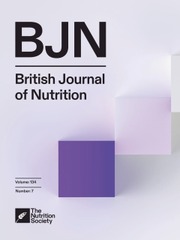Crossref Citations
This article has been cited by the following publications. This list is generated based on data provided by
Crossref.
Rouzaud, Gabrielle
Young, Sheila A.
and
Duncan, Alan J.
2004.
Hydrolysis of Glucosinolates to Isothiocyanates after Ingestion of Raw or Microwaved Cabbage by Human Volunteers.
Cancer Epidemiology, Biomarkers & Prevention,
Vol. 13,
Issue. 1,
p.
125.
Bianchini, Franca
and
Vainio, Harri
2004.
Isothiocyanates in Cancer Prevention.
Drug Metabolism Reviews,
Vol. 36,
Issue. 3-4,
p.
655.
Li, Xian
and
Kushad, Mosbah M.
2005.
Purification and characterization of myrosinase from horseradish (Armoracia rusticana) roots.
Plant Physiology and Biochemistry,
Vol. 43,
Issue. 6,
p.
503.
Morrison, John J.
and
Botting, Nigel P.
2005.
The synthesis of [phenyl-2H5]gluconasturtiin and its metabolites for metabolic studies.
Journal of Labelled Compounds and Radiopharmaceuticals,
Vol. 48,
Issue. 12,
p.
897.
Rose, Peter
2005.
Hydrogen sulfide protects colon cancer cells from chemopreventative agent β-phenylethyl isothiocyanate induced apoptosis.
World Journal of Gastroenterology,
Vol. 11,
Issue. 26,
p.
3990.
Humblot, Christèle
Bruneau, Aurélia
Sutren, Malène
Lhoste, Evelyne F.
Doré, Joël
Andrieux, Claude
and
Rabot, Sylvie
2005.
Brussels sprouts, inulin and fermented milk alter the faecal microbiota of human microbiota-associated rats as shown by PCR-temporal temperature gradient gel electrophoresis using universal,Lactobacillus and Bifidobacterium16S rRNA gene primers.
British Journal of Nutrition,
Vol. 93,
Issue. 5,
p.
677.
FINLEY, JOHN W.
2005.
Proposed Criteria for Assessing the Efficacy of Cancer Reduction by Plant Foods Enriched in Carotenoids, Glucosinolates, Polyphenols and Selenocompounds.
Annals of Botany,
Vol. 95,
Issue. 7,
p.
1075.
Smith, Tracy K.
Lund, Elizabeth K.
Clarke, Rosemary G.
Bennett, Richard N.
and
Johnson, Ian T.
2005.
Effects of Brussels Sprout Juice on the Cell Cycle and Adhesion of Human Colorectal Carcinoma Cells (HT29) in Vitro.
Journal of Agricultural and Food Chemistry,
Vol. 53,
Issue. 10,
p.
3895.
Hwang, Eun-Sun
and
Jeffery, Elizabeth H.
2005.
Induction of Quinone Reductase by Sulforaphane and Sulforaphane N-Acetylcysteine Conjugate in Murine Hepatoma Cells.
Journal of Medicinal Food,
Vol. 8,
Issue. 2,
p.
198.
Vermeulen, Martijn
van den Berg, Robin
Freidig, Andreas P.
van Bladeren, Peter J.
and
Vaes, Wouter H. J.
2006.
Association between Consumption of Cruciferous Vegetables and Condiments and Excretion in Urine of Isothiocyanate Mercapturic Acids.
Journal of Agricultural and Food Chemistry,
Vol. 54,
Issue. 15,
p.
5350.
Henriksson, Anders
2006.
Gastrointestinal Microbiology.
p.
253.
Moreno, D.A.
Carvajal, M.
López-Berenguer, C.
and
García-Viguera, C.
2006.
Chemical and biological characterisation of nutraceutical compounds of broccoli.
Journal of Pharmaceutical and Biomedical Analysis,
Vol. 41,
Issue. 5,
p.
1508.
Engelen-Eigles, Gerard
Holden, Greg
Cohen, Jerry D.
and
Gardner, Gary
2006.
The Effect of Temperature, Photoperiod, and Light Quality on Gluconasturtiin Concentration in Watercress (Nasturtium officinale R. Br.).
Journal of Agricultural and Food Chemistry,
Vol. 54,
Issue. 2,
p.
328.
Botting, Nigel P.
Robertson, Avril A. B.
and
Morrison, John J.
2007.
The synthesis of isotopically labelled glucosinolates for analysis and metabolic studies.
Journal of Labelled Compounds and Radiopharmaceuticals,
Vol. 50,
Issue. 5-6,
p.
260.
Johnson, Ian T.
2007.
Phytochemicals and cancer.
Proceedings of the Nutrition Society,
Vol. 66,
Issue. 2,
p.
207.
Tripathi, M.K.
and
Mishra, A.S.
2007.
Glucosinolates in animal nutrition: A review.
Animal Feed Science and Technology,
Vol. 132,
Issue. 1-2,
p.
1.
Rungapamestry, Vanessa
Duncan, Alan J.
Fuller, Zoë
and
Ratcliffe, Brian
2007.
Effect of cooking brassica vegetables on the subsequent hydrolysis and metabolic fate of glucosinolates.
Proceedings of the Nutrition Society,
Vol. 66,
Issue. 1,
p.
69.
Fimognari, Carmela
and
Hrelia, Patrizia
2007.
Sulforaphane as a promising molecule for fighting cancer.
Mutation Research/Reviews in Mutation Research,
Vol. 635,
Issue. 2-3,
p.
90.
Nakamura, Yoshimasa
Yoshimoto, Motoko
Murata, Yoshiyuki
Shimoishi, Yasuaki
Asai, Yumi
Park, Eun Young
Sato, Kenji
and
Nakamura, Yasushi
2007.
Papaya Seed Represents a Rich Source of Biologically Active Isothiocyanate.
Journal of Agricultural and Food Chemistry,
Vol. 55,
Issue. 11,
p.
4407.
Bheemreddy, Radha M.
and
Jeffery, Elizabeth H.
2007.
The Metabolic Fate of Purified Glucoraphanin in F344 Rats.
Journal of Agricultural and Food Chemistry,
Vol. 55,
Issue. 8,
p.
2861.

